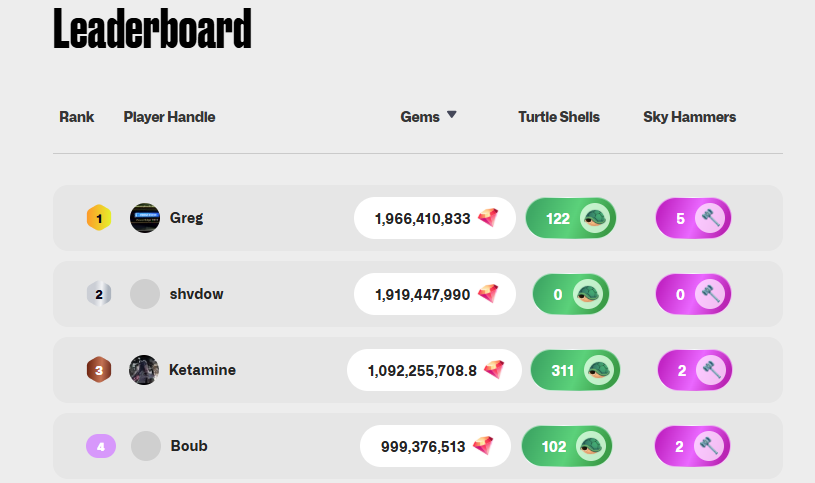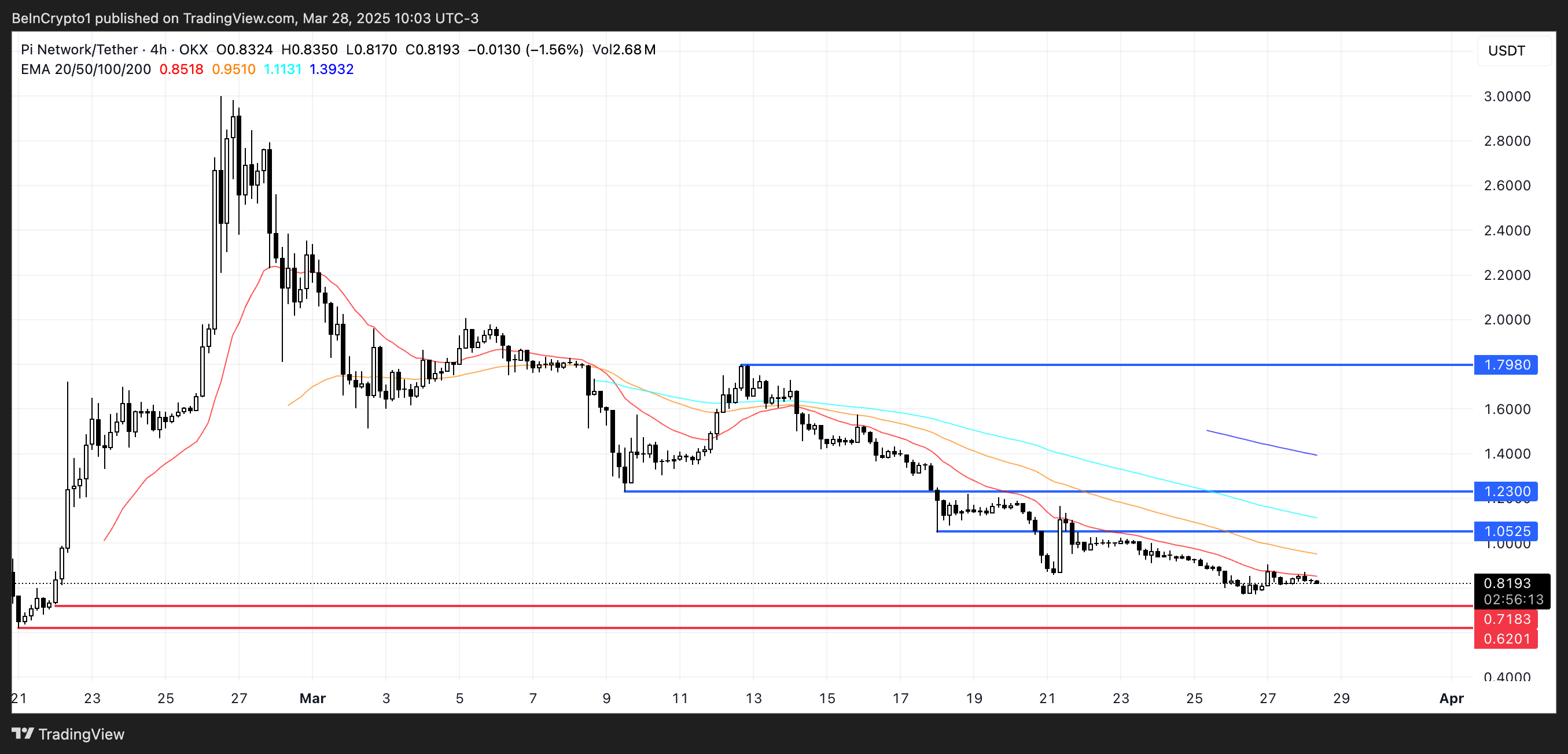Market
3 Exciting Projects To Watch This Week

As crypto markets enter the last week of March, airdrop farmers are eyeing lucrative opportunities to join promising projects while still on the ground floor stage.
Here are three promising projects worth your attention for airdrop farmers looking to engage with a promising Bitcoin Layer-2 (L2), a unique Proof-of-Work (PoW) protocol, or an Ethereum scaling solution.
GOAT Network: Transforming Bitcoin into an Active Asset
GOAT Network is making waves as a Layer-2 solution. It expands Bitcoin’s capabilities with smart contracts and decentralized finance (DeFi). Officially launched on its Alpha Mainnet on March 17, 2025, the project is moving away from traditional one-time airdrops. Instead, it favors an ongoing rewards system via its “One Piece Project.”
“The launch of our alpha mainnet gives everyone the chance to earn in multiple ways,” GOAT Network shared.
Participants can bridge assets like native BTC, BTCB, or Dogecoin (DOGE). They can also mint soulbound NFTs (non-fungible tokens) and engage with dApps such as GOATSwap and Oku. Users earn GEC (Proof of Activity) and GOAT Points. These will later be convertible to GOATED tokens after the Token Generation Event (TGE). Notably, the TGE is scheduled for later in 2025.
Early adopters are encouraged to interact with the network actively, as airdrop rewards scale based on engagement.
Up to 6% of the GOAT token supply has been allocated for airdrops. Meanwhile, they reserved 42% for sequencer and community mining and an additional 1% for influencer partnerships. The focus remains community-driven growth, rewarding users who contribute liquidity and interact with dApps.
With a public mainnet and the TGE on the horizon, GOAT Network is positioning itself as a key player in the growing Bitcoin DeFi space.
Tari: A PoW Network Rewarding Early Engagement
Tari is a novel Layer-1 blockchain emphasizing user-driven proof-of-work and digital asset management. With its mainnet launch scheduled for April 2025, airdrop farmers have a prime opportunity to accumulate Gems. This could factor into future token distributions.
Meanwhile, the leaderboard shows top players with huge loads of Gems. This highlights a significant gap that raises concerns about a “whale-capped” airdrop distribution to prevent top-heavy rewards.
“Thought I was doing reasonably well with my 85K TARI gems but looking at the leaderboard I’m a little bit behind the top guys Surely this must be whale capped somehow otherwise the airdrop will be pretty top heavy,” one airdrop farmer remarked.

The project has allocated 5% of the total XTM supply for incentive programs. Airdrop distribution is planned to take place approximately six months after the mainnet launch. However, community tokens will be subject to a 12-month vesting period.
Users can accumulate Gems by mining tXTM (testnet Tari) via Tari Universe. Additional methods include completing quests, referring friends, and holding Yats domain names with high rhythm scores.
Additionally, rarer collectibles called “Turtle Shells” and “Sky Hammers” may offer multipliers or boosts to airdrop eligibility, making them highly sought-after by dedicated participants. Tari’s proof-of-work algorithm is designed to be ASIC-resistant (ASIC—Application-Specific Integrated Circuits). This ensures the fair distribution of mining rewards among real users rather than large-scale mining farms.
Noteworthy, US residents are ineligible for the airdrop. However, global participants can still take advantage of this early-stage opportunity before testnet mining concludes at the mainnet launch.
MegaETH: An NFT-Based Approach to Airdrops
Unlike the typical airdrop farming model, MegaETH is taking a different approach. This Ethereum Layer-2 solution boasts 100,000 transactions per second (TPS). It has secured backing from Vitalik Buterin and a $20 million seed round.
Instead of offering free tokens to Sybil-heavy farmers, MegaETH opts for an NFT-based rewards mechanism. While its testnet is now live, the project has announced that there will be no immediate rewards for participation. However, many in the community speculate that interactions with the testnet may affect future eligibility.
“…btw no airdrop for using public testnet purpose is for us to battle-test, for builders to explore the tech unlock, and for users to experience real-time apps for the first time nothing against points just not our vibe,” MegaETH articulated.
There is no direct airdrop confirmed yet, but testnet interactions are free and may affect future rewards. MegaETH Airdrop farmers should monitor related projects like CAP Labs and Noise for potential early access clues.
Some community members have expressed frustration with the lack of an official airdrop. However, MegaETH’s novel approach may ultimately benefit long-term participants.
With airdrops remaining a major incentive in the crypto space, these three projects offer distinct opportunities for users to get involved.
Disclaimer
In adherence to the Trust Project guidelines, BeInCrypto is committed to unbiased, transparent reporting. This news article aims to provide accurate, timely information. However, readers are advised to verify facts independently and consult with a professional before making any decisions based on this content. Please note that our Terms and Conditions, Privacy Policy, and Disclaimers have been updated.
Market
South Carolina Could Spend 10% of Funds on Bitcoin Reserve


Representative Jordan Pace introduced legislation to create a Bitcoin Reserve for South Carolina, joining a nationwide effort. Currently, nearly half of all US states have an active bill to create a similar Reserve.
However, the talking point that this bill “allows 10% of state funds” in Bitcoin investments is taking off like wildfire. It may scare off fiscal conservatives, which contributed to recent failures.
South Carolina Joins the Bitcoin Reserve Race
Since President Trump announced his intention to create a US Bitcoin Reserve, many state governments have attempted to create smaller models.
In the last month, these efforts have been intensifying, with more and more states joining the effort. Today, South Carolina filed its own Bitcoin Reserve bill, allowing the state to make substantial purchases:
“The State Treasurer may invest in digital assets including, but not limited to, Bitcoin with money that is unexpended, unencumbered, or uncommitted. The amount of money that the State Treasurer may invest in digital assets from a fund specified in this section may not exceed ten precent of the total funds under management,” it reads.
State Representative Jordan Pace proposed South Carolina’s Bitcoin Reserve legislation. He claimed that this bill “gives the Treasurer new tools to protect taxpayer dollars from inflation,” one of crypto’s most well-known use cases. Pace is currently the bill’s only sponsor, and it’s unclear what chances it has of passing.
Still, there may be challenges ahead. Similar proposals in other Republican-led states—like Montana and Wyoming—have already failed. This was largely due to concerns over using public funds to buy cryptocurrency.
Even though Trump backs the idea on a national level, not all GOP lawmakers are convinced at the state level.
That said, there are some signs of progress elsewhere. For example, Texas has advanced its Bitcoin Reserve bill, achieving bipartisan support. A key reason for its success is that the bill doesn’t require the state to make crypto purchases; it simply allows them at the Treasurer’s discretion.
Likewise, South Carolina’s bill wouldn’t force the state to invest 10% of its funds into Bitcoin. It just opens the door for that possibility, giving the state financial flexibility rather than a mandate.
Disclaimer
In adherence to the Trust Project guidelines, BeInCrypto is committed to unbiased, transparent reporting. This news article aims to provide accurate, timely information. However, readers are advised to verify facts independently and consult with a professional before making any decisions based on this content. Please note that our Terms and Conditions, Privacy Policy, and Disclaimers have been updated.
Market
FDIC and CFTC Rescind Old Crypto Guidelines


The FDIC and CFTC have both been working to change previous crypto guidelines. As federal regulators reconcile with the industry, they are removing old rules that specifically target crypto.
The former institution is removing the requirement that banks report crypto business, while the latter holds crypto to the same standards as other industries.
FDIC and CFTC Change Crypto Policies
The FDIC is one of the top financial regulators in the US, and it’s turning over a new leaf. After being one of the principal architects of Operation Choke Point 2.0, it recently began declassifying documents and changing rules that allowed crypto debanking.
Today, the agency is revoking a 2022 directive that impacted banks’ interactions with crypto:
“With today’s action, the FDIC is turning the page on the flawed approach of the past three years. I expect this to be one of several steps the FDIC will take to lay out a new approach for how banks can engage in crypto- and blockchain-related activities in accordance with safety and soundness standards,” said FDIC Acting Chairman Travis Hill.
Specifically, it rescinded a rule that mandated that all banks and institutions under its supervision notify the FDIC of any crypto involvement. The new guideline claims that banks “may engage in permissible crypto-related activities without receiving prior FDIC approval” without enacting any other policies.
Since Gary Gensler left the SEC, all the top US financial regulators have been trying to rework their relationship with crypto. In an apparent coincidence, the CFTC made a very similar move to the FDIC by rescinding two crypto guidelines.
Both of these actions did not establish a new policy; they merely removed the old ones.
Essentially, both of the CFTC’s rule changes are set to ensure that crypto-related derivatives are subject to the same requirements as non-crypto ones. This is somewhat surprising, considering that the industry has typically tried to insist that it necessitates specific regulations.
However, this is largely beside the point. The FDIC and CFTC are both working to remove previous guidelines that opposed the crypto industry.
These institutions will undoubtedly be amenable to creating new ones in the spirit of cooperation. In the meantime, this olive branch can help build a lot of goodwill.
Disclaimer
In adherence to the Trust Project guidelines, BeInCrypto is committed to unbiased, transparent reporting. This news article aims to provide accurate, timely information. However, readers are advised to verify facts independently and consult with a professional before making any decisions based on this content. Please note that our Terms and Conditions, Privacy Policy, and Disclaimers have been updated.
Market
Pi Network (PI) Drops Further Despite Telegram Wallet Deal

Pi Network (PI) has been under heavy selling pressure, with its price down more than 61% over the last 30 days. Despite a recent partnership with the Telegram Crypto Wallet, PI has struggled to regain momentum, as technical indicators remain mostly bearish.
Its BBTrend has been negative for 12 consecutive days, and although the RSI has recovered slightly from oversold levels, it still sits below the neutral 50 mark. With the downtrend firmly intact and critical support levels approaching, PI’s next move will likely depend on whether buyers can step in and reverse the current trajectory.
PI BBTrend Has Been Negative For 12 Days
Pi Network (PI) continues to face bearish pressure, as reflected in its BBTrend indicator, which remains deep in negative territory at -22.34.
This is despite recent headlines about the Telegram Crypto Wallet integrating Pi Network, news that has yet to translate into sustained upward momentum.
The BBTrend hit a recent low of -41 on March 21 and has stayed negative since March 16, marking twelve consecutive days of bearish trend signals. This prolonged weakness highlights the ongoing struggle for buyers to regain control of the market.

BBTrend, or Bollinger Band Trend, is a momentum-based indicator that helps gauge the strength and direction of a trend. Positive BBTrend values indicate bullish momentum, while negative values point to bearish sentiment—the further from zero, the stronger the trend.
With PI’s BBTrend sitting at -22.34, the market remains firmly under bearish influence, even if the worst of the recent downtrend may be easing slightly from its extreme lows.
Unless this trend flips back into positive territory soon, PI’s price could remain under pressure, with buyers staying cautious despite the recent integration news.
Pi Network RSI Has Recovered From Oversold But Still Lacks Bullish Momentum
Pi Network is showing early signs of recovery in momentum, with its Relative Strength Index (RSI) rising to 40.45 after hitting 23.8 just two days ago.
While this rebound suggests a reduction in overselling pressure, PI’s RSI hasn’t crossed above the neutral 50 mark in the past two weeks—highlighting ongoing weakness in bullish conviction.
Despite the slight uptick, the market has yet to see enough strength to shift sentiment meaningfully in favor of buyers. This cautious climb could either lead to a breakout or stall into continued consolidation.

The RSI, or Relative Strength Index, is a momentum oscillator that measures the speed and change of price movements. It ranges from 0 to 100, with values above 70 indicating overbought conditions and those below 30 suggesting the asset is oversold.
With PI’s RSI currently at 40.45, it’s in a neutral-to-bearish zone—no longer extremely oversold but still lacking strong buying pressure.
For a clearer trend reversal, the RSI would likely need to break above 50, which hasn’t happened in two weeks. Thus, the current move is more of a potential bottoming attempt rather than a confirmed shift.
Will PI Continue Its Correction?
PI price is currently trading within a well-established downtrend, as indicated by the alignment of its EMA (Exponential Moving Average) lines—where shorter-term EMAs remain firmly below longer-term ones.
This setup reflects persistent selling pressure, and if the correction continues, PI could revisit key support levels at $0.718, with a potential drop to $0.62 if that floor fails to hold.

However, recent signs of life in the RSI hint that a short-term rebound might be brewing, offering some hope for a recovery.
If bullish momentum builds, PI could challenge resistance at $1.05 in the near term. A breakout above that level would shift sentiment and open the door for further gains, with $1.23 and even $1.79 as potential targets if the uptrend strengthens.
Disclaimer
In line with the Trust Project guidelines, this price analysis article is for informational purposes only and should not be considered financial or investment advice. BeInCrypto is committed to accurate, unbiased reporting, but market conditions are subject to change without notice. Always conduct your own research and consult with a professional before making any financial decisions. Please note that our Terms and Conditions, Privacy Policy, and Disclaimers have been updated.
-

 Altcoin19 hours ago
Altcoin19 hours agoDogecoin Price Set To Reach $1 As Once In A Year Buy Opportunity Returns
-

 Altcoin21 hours ago
Altcoin21 hours agoBlessing or Curse for the Crypto Market?
-

 Market20 hours ago
Market20 hours agoHedera Falls 4% as Bears Dominate: What’s Next for HBAR?
-

 Regulation16 hours ago
Regulation16 hours agoFDIC Revises Crypto Guidelines Allowing Banks To Enter Digital Assets
-

 Altcoin20 hours ago
Altcoin20 hours agoWhy the US SEC Is Delaying the Ripple Case?
-

 Ethereum20 hours ago
Ethereum20 hours agoEthereum Fails To Break $2,100 Resistance – Growing Downside Risk?
-

 Market19 hours ago
Market19 hours agoAnalysts Reveal Q2 Crypto Market Outlook: BTC at $200,000?
-

 Market14 hours ago
Market14 hours agoCoinbase Users Lost $46 Million to Crypto Scams in March






















